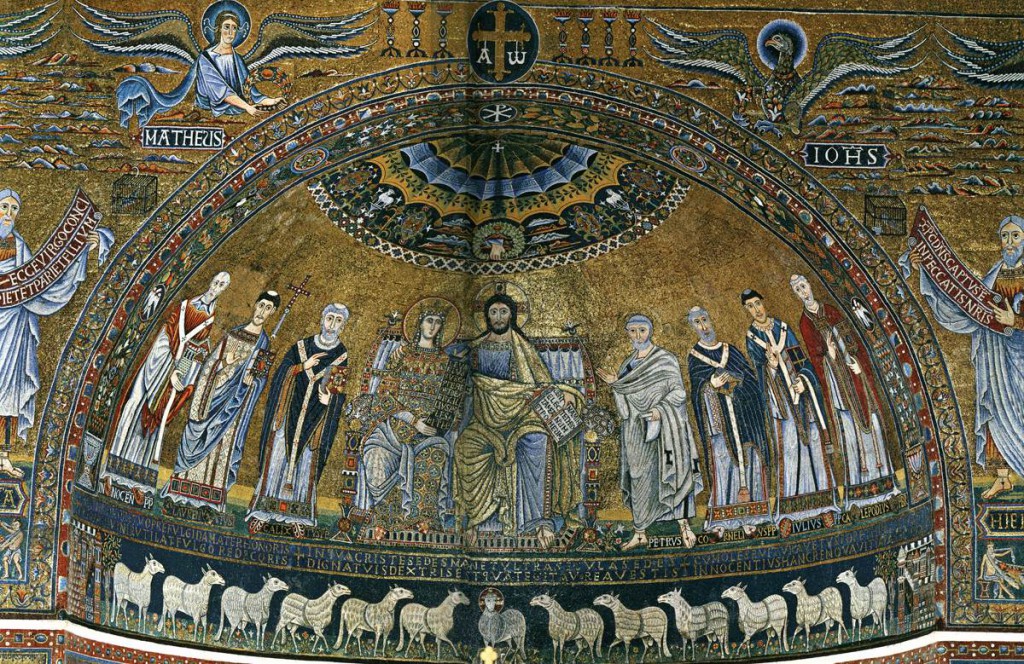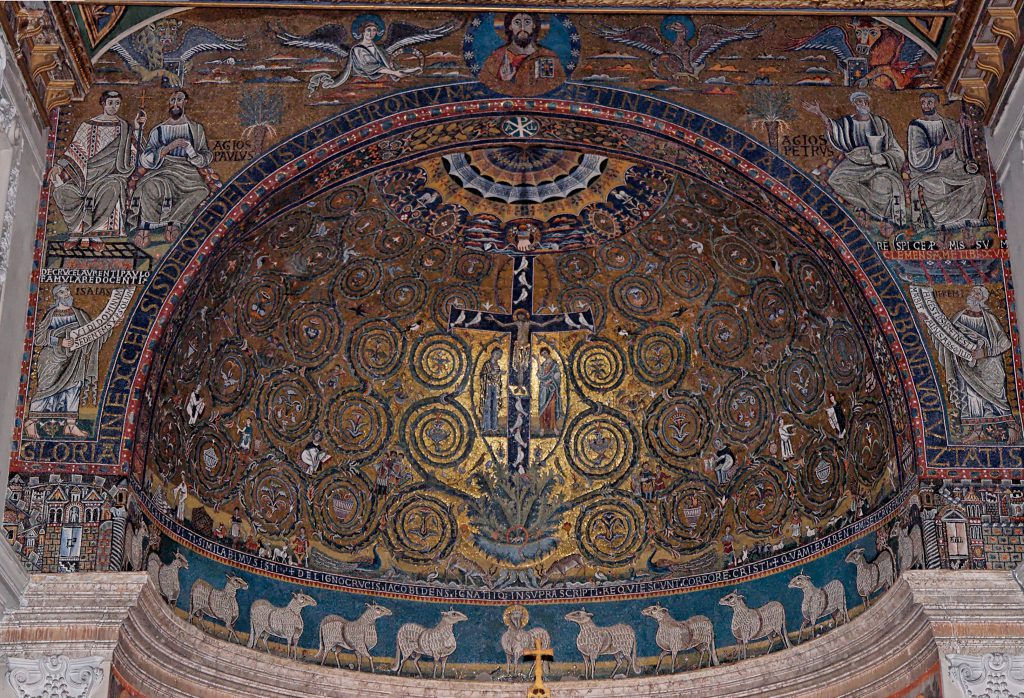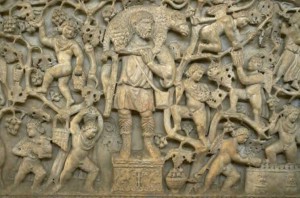Those who generally frequent Holy Mass with the traditional form of the Roman Rite heard the Gospel about the Good Shepherd last week. In the Novus Ordo, that Gospel is read this week, for the 4th Sunday of Easter.
It’s really too bad that there is a disconnect. I’m not sure why the experts of the Consilium thought it was so important to break the continuity of hundreds of years like that. But let’s keep moving.
For this 4th Sunday of Easter, Novus Ordo Good Shepherd Sunday, we have a little gem for a Collect which goes back to the time of the Gelasian Sacramentary.
Omnipotens sempiterne Deus, deduc nos ad societatem caelestium gaudiorum, ut eo perveniat humilitas gregis, quo processit fortitudo pastoris.
Whoever wrote this was a true master of faith, thought and language.
Note the nice eo…quo construction and the rhythmic endings of clauses which makes the prayer so singable. There is synchesis in the last part, a parallelism of grammatical forms “ut A-B-C-D, A-B-C-D”.
The prayer’s structure resembles the orderly procession which the vocabulary invokes.
Procedo is “to come forth” as well as “to advance, proceed to.” It comes also to mean, “to result as a benefit for” someone or something. Think of English “proceeds”, as in money raised for a cause. “Procession” (apart from the liturgical meaning) is a theological term describing how the Persons of the Trinity relate to each other.
A societas is “a fellowship, association, union, community”, that is, a group united for some common purpose. I’ll render it as “communion”, which gets to the relationship we will have in heaven and, in anticipation, as members of Holy Church.
There is a nice contrast in humilitas and fortitudo. They seem to be opposites. (Hint: they’re not.)
True to the ancient Roman spirit, humilitas has the negative connotation of “lowness”, in the sense of being base or abject: humus means “soil”. On the other hand, fortitudo means “strength” and even “the manliness shown in enduring or undertaking hardship, bravery, courage.” In the 8th century Gelasian Sacramentary, whence comes today’s prayer, that fortitudo was originally celsitudo (“loftiness of carriage”, also a title like “Highness”). Fortitudo could poetically refer to Christ’s moral strength and endurance in His Passion and death. Moreover, Our Lord chooses the weak and makes them strong with His strength, His fortitudo (cf 1 Corinthians 1:26-28).
Weakness and strength are not to be measured by worldly successes.
LITERAL ATTEMPT:
Almighty eternal God, lead us unto the communion of heavenly joys, so that the humility of the flock may attain that place to which the might of the shepherd has advanced.
OBSOLETE ICEL (1973):
Almighty and ever-living God, give us new strength from the courage of Christ our shepherd, and lead us to join the saints in heaven.
CURRENT ICEL (2011):
Almighty ever-living God, lead us to a share in the joys of heaven, so that the humble flock may reach where the brave Shepherd has gone before.
Translators occasionally turn an abstract idea that sounds like a possessive (a trope called synecdoche), as in “the humility of the flock” or “the might of the shepherd”, into a characteristic of the possessor, as in “the humble flock” or “the mighty shepherd”. I think we lose something beautiful in that exchange. You decide.
In our Collect is the image of Christ as shepherd. In mighty resolve He goes before – precedes us, the humble flock. He leads us back to that from which He first proceeded, communion with the Father and the Spirit.
Going forth. Turning. Going back.
In the Greek Neo-Platonic philosophy that informed early Christian thought we often find the paradigm of going forth (proodos, or Latin exitus), a turning around, and returning back (epistrophe, reditus). This common ancient pattern is echoed in today’s ancient prayer.
This Collect also reminds me of mosaics in the apses of Christian basilicas.
Mosaics are assembled from tiny bits of colored stone, tesserae, into beautiful spiritual works with many symbols. Up close, individual tesserae are unremarkable, often flawed. Once a great artist gathers and arranges them according to a plan, they proceed to dazzle and amaze.
Holy Church is like a mosaic.
Just as one tessera makes the others more beautiful, we small individual Catholics, with different vocations, in diverse places, and even distant eras in history, play important roles in a larger societas.
 The mosaics in apses of ancient and Romanesque churches often depict Christ dressed in glorious imperial trappings. Apostles and saints, His celestial court, stand on either side bracketed in turn by Bethlehem or the earthly and heavenly Jerusalem. Beneath the feet of Christ, mighty Shepherd King, are lines of courtly sheep, hooves elegantly raised as they process into a green safe place where water flows, symbolizing the river Jordan and our baptism, the refrigerium we evoke in the Roman Canon.
The mosaics in apses of ancient and Romanesque churches often depict Christ dressed in glorious imperial trappings. Apostles and saints, His celestial court, stand on either side bracketed in turn by Bethlehem or the earthly and heavenly Jerusalem. Beneath the feet of Christ, mighty Shepherd King, are lines of courtly sheep, hooves elegantly raised as they process into a green safe place where water flows, symbolizing the river Jordan and our baptism, the refrigerium we evoke in the Roman Canon.
The Second Person of the Trinity, the Son, proceeded from the Father from all eternity. He proceeded into this world in a mighty gesture of self-emptying in order to save us from our sins, turn us away from sin and death, and open for us the way to salvation.
In His first coming, Christ came in humility to take up our fallen societas, our humilitas, His grex, into an indestructible societas with His divinity.
In His second coming, clothed in His own fortitudo He will shepherd us into a new societas in heaven.
If you are a sheep who has strayed, come back now to His fold, Holy Catholic Church. GO TO CONFESSION!
I include in this category of straying sheep those who dissent from the doctrine of the Church the Good Shepherd founded.




































Basilica of St. Praxedis?
What is ICEL’s “ever living” issue with the word “eternal” ?